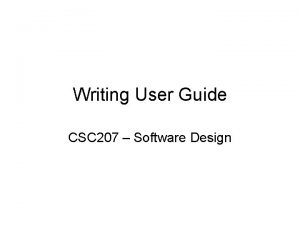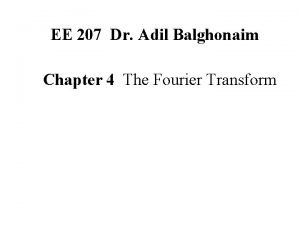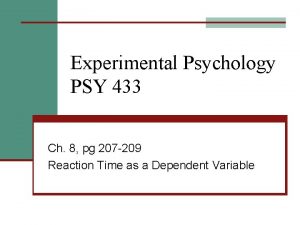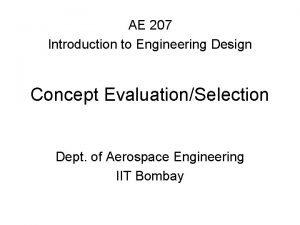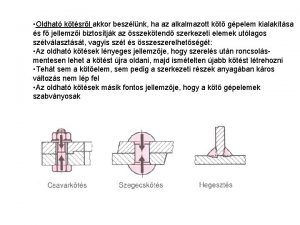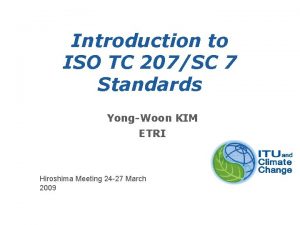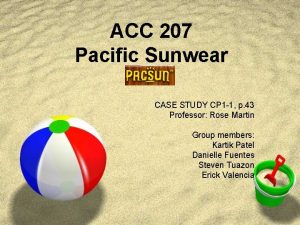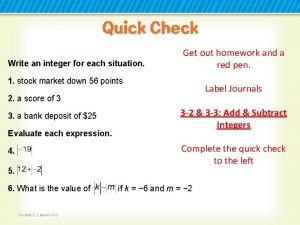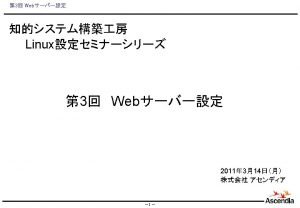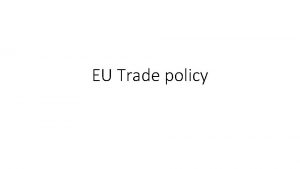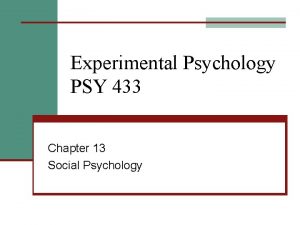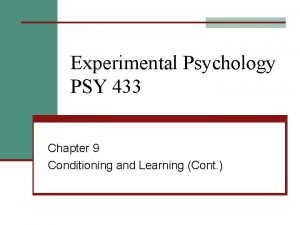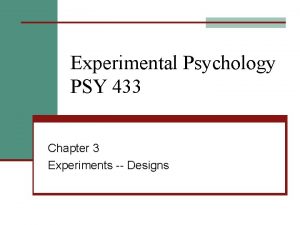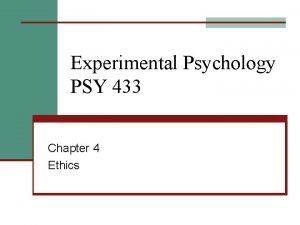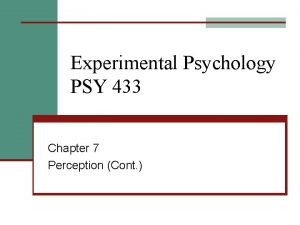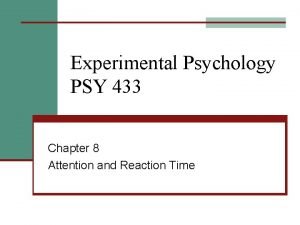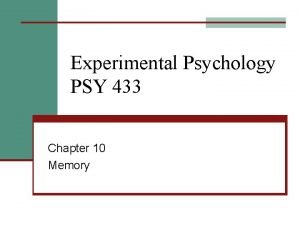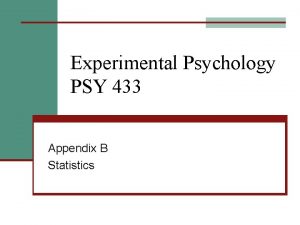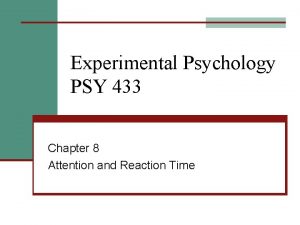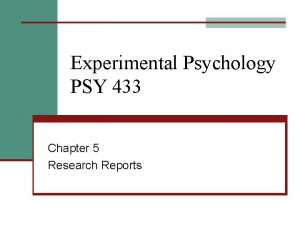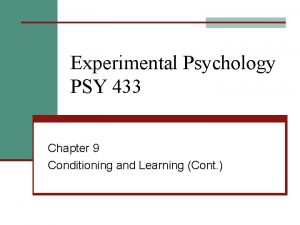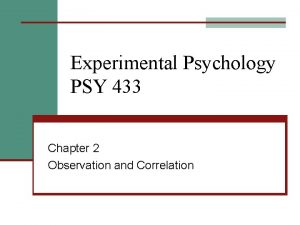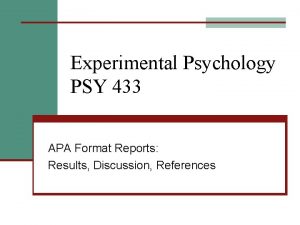Experimental Psychology PSY 433 Ch 8 pg 207















- Slides: 15

Experimental Psychology PSY 433 Ch. 8, pg 207 -209 Reaction Time as a Dependent Variable

Some Terminology n Dependent variable (DV) – the variable measured and recorded by the experimenter. n Independent variable (IV) – the variable manipulated by the experimenter. n In an experiment, changing the IV should produce a corresponding change in the DV, demonstrating a causal relationship. n Studies can have multiple DV’s (called multivariate) or multiple IV’s (called factorial).

Donders Tasks n S 1 R 1 Donders A n S 1 R 1 Donders B S 2 R 2 n S 1 R 1 S 2 Donders C

Measuring RT – Donders A n The two most common DVs in experimental psychology are percent correct and reaction time (RT). n There are several types of RT n Reaction time vs response time n Simple RT (Donders A): the time between the onset of a stimulus and the onset of a response. n Requires time for sensory processing, nerve conduction, and responding.

Measuring RT – Donders C n Go No. Go (Donders C): the time between the onset of one of multiple possible stimuli and the onset of a response to only a single one of those stimuli. n Requires time for all processes in simple RT plus time for stimulus identification.

Measuring RT – Donders B n Choice RT (Donders B): the time between the onset of one of multiple possible stimuli and the onset of a unique response to each stimulus. n Requires time for all processes in simple RT plus time for stimulus identification and time for response selection.

Donders A -- Simple A Reaction Time (total) Perceive stimulus and press key

Donders C – Go-No Go C Reaction Time (total) Perceive stimulus, decide if it is the one requiring you to press a key, press the key

Isolating and Measuring the Two Components of the Task A Reaction Time C Minus A The two steps (perceive a stimulus and decide whether to press a key or not) can be separated and the time needed for each determined by subtraction.

Donders B -- Choice B Reaction Time (total) C Reaction Time (total) B Minus C Baseline Identification Time Selection Time

The Subtractive Method n A: See a stimulus Press a key n B: See a stimulus Identify which one it is Decide which key to press Press a key n C: See a stimulus Identify which one it is Press a key or not

Measuring the Separate Parts n A is the Simple task n B is the Choice task n C is the Go-No. Go task n A is how long it takes to see a stimulus and press a key. n To figure out how long it takes to identify the stimulus, subtract A from C. n To figure out how long it takes to decide which key to press, subtract B from C.

Subtractive Method in Experiments n Define two or more groups (levels of the IV): n Group 1 – Control group n Group 2 – Experimental (treatment) group n Measure both groups n Subtract Group 2 from Group 1 n The difference is the effect n The effect is the amount attributable to whatever happened differently in Group 2. n If there is no measurable difference between the two, there is no effect.

Reaction Time Expt (Uncleaned) Task Simple 1. 600 1. 400 1. 200 1. 000 RT Go/No. Go 0. 800 0. 600 0. 400 Choice 0. 200 0. 000 Simple Go/No. Go Task Choice Mean P 1 St. Dev. P 1 Min P 1 Max P 1 N P 1 SE P 1 Mean P 2 St. Dev. P 2 Min P 2 Max P 2 N P 2 SE P 2 Mean P 3 St. Dev. P 3 Min P 3 Max P 3 N P 3 SE P 3 1. 042 1. 975 0. 253 9. 22 20 0. 44 0. 426 0. 067 0. 317 0. 53 20 0. 02 0. 477 0. 100 0. 301 0. 71 20 0. 02

Reaction Time Expt (Cleaned) Task Simple 0. 600 0. 500 RT 0. 400 0. 300 0. 200 0. 100 0. 000 Simple Go/No. Go Task Choice Mean P 1 St. Dev. P 1 Min P 1 Max P 1 N P 1 SE P 1 Go/No. Go Mean P 2 St. Dev. P 2 Min P 2 Max P 2 N P 2 SE P 2 Choice Mean P 3 St. Dev. P 3 Min P 3 Max P 3 N P 3 SE P 3 0. 343 0. 072 0. 253 0. 50 19 0. 02 0. 426 0. 069 0. 317 0. 53 19 0. 02 0. 454 0. 077 0. 301 0. 64 19 0. 02
 Experimental vs non experimental
Experimental vs non experimental Nonexperimental study
Nonexperimental study Descriptive vs correlational vs experimental research
Descriptive vs correlational vs experimental research Disadvantages of experimental research
Disadvantages of experimental research Experimental vs nonexperimental
Experimental vs nonexperimental Csc 207
Csc 207 Adil balghonaim
Adil balghonaim Pg 207
Pg 207 Ae 207
Ae 207 Zsinórmenet
Zsinórmenet 1952 okul öncesi eğitim programı
1952 okul öncesi eğitim programı Iso/tc 207
Iso/tc 207 Acc 207
Acc 207 Write an instruction for each situation
Write an instruction for each situation Apche 207
Apche 207 Article 207 tfeu
Article 207 tfeu





